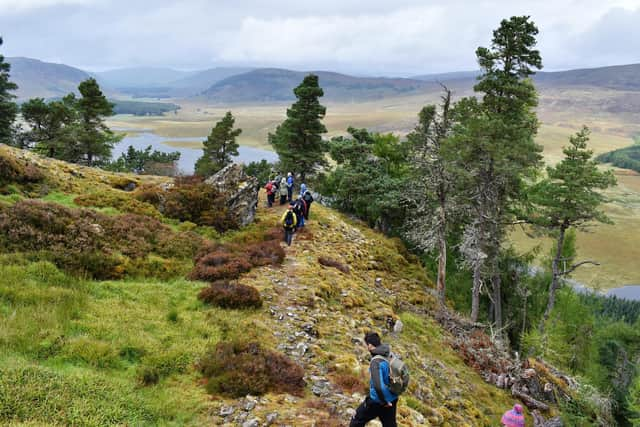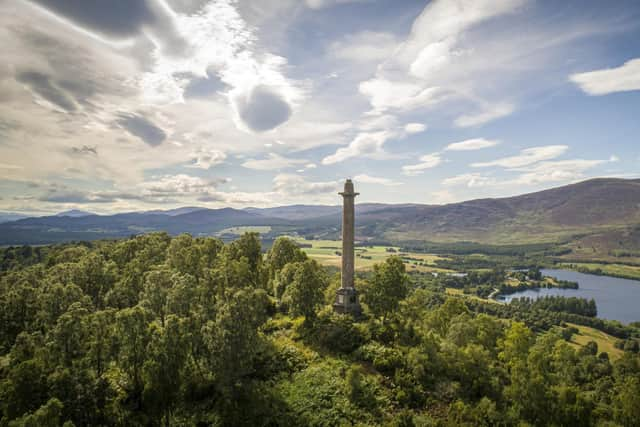A hiker’s delight: the little known paths through Badenoch, Cairngorms in the Scottish Highlands.
Munro baggers will be happy here in the heart of the Cairngorms but what you also find is a buzzing network of trails and tracks that take you deep into the surrounds for adventures high on rewards but perhaps a little less hard on the tax.
And embarking on a shorter walk means there is more of the day to play – and definitely more time for lunch. It is easily possible to combine interesting routes and moment-stopping views with a fine, hot meal prepared from the goods held in Badenoch’s ample natural larder.
A taste of Scotland


You’ll nail this joyous combination of walking and eating if you head to Dalraddy Holiday Park, where you will find Chris McCall and his Alvie Forest Foods truck parked among the trees. Chris cheffed for years at the acclaimed Old Bridge Inn in Aviemore and has managed to bring quality dining into the great outdoors. The menu has that street, relaxed feel with dishes such as honey chilli chicken and fries, venison meatballs with chorizo and broth cep shoyo – which he ferments himself – but it is hard to box a place up like this with labels.
Chris is passionate about local ingredients, foraging and celebrating what the land here offers. After spotting a pile of plucked feathers, I found him in his tiny kitchen at the back of his truck chopping up a mallard he got from the Alvie Estate that morning. It wasn't long after that he handed over a compostable takeaway box loaded with thick slices of the gorgeously purple and plump bird, gravy from foraged ceps from the woods at the back, smashed tatties in black garlic oil and a wee roasted pear.
It was among the most enjoyable meals possible, devoured under the canopy of the birches, the flavours elemental and drawn straight from the surrounding environment and the piping hot meal incurring a glow of enjoyment against the cool autumnal air. There is also a great coffee van – Cabin Coffee – next door so after a shot of something dark and energising, it was time to hit the trail up Torr Alvie. For the five kilometres or so ahead, I was extremely well set.
History yet to be discovered


It is believed Torr Alvie was once a Pictish fort and, interestingly, there is also now a school of thought that the Battle of Nechtansmere, fought against the Northumbrians with the Pictish victory paving the way to the creation of the Scottish nation, was fought in the gap between the hills. It's a tantalising theory that instantly ramps up the drama of this already amped-up landscape.
As you make your way to the foot of the hill, you’ll pass a pretty average looking field full of cow pats. Underneath, lies the largest Pictish cemetery ever found in Scotland. A sharp pick up of breeze as I wandered across this ancient site had me quicken my step.
The Croftgowan cemetery is home to dozens of barrows, or burial mounds, which are 1,100 years old. Around 1800, pieces of sword blades, and buckles were discovered with the secrets of the fields further revealed in 2018 when the dry summer exposed previously unseen crop marks and a new group of round barrows.
In 2021, volunteers working alongside University of Aberdeen’s Northern Picts project uncovered preserved human remains – including enamel caps from their teeth – in one round barrow. In another, the “remarkable” body stain of a person interred in the grave was found.
As you stand in the field, and look up to Torr Alvie, the pieces of the past assemble themselves.
Waterloo remembered
Onwards and up through the birch, juniper and pines towards the peak, where the monument to the 5th Duke of Gordon, towers more than 300-metres high and surveys all that lies beneath it. Standing where Pictish rulers may have assembled, the memorial to the aristocrat was built by public subscription in 1840, four years after the death of the 5th Duke, The Waterloo Carin, also on Torr Alvie, was erected by the landowner to commemorate local men killed at Waterloo.
A memorial to Jane Maxwell, the Duchess of Gordon, wife of the 4th Duke is also found. She was estranged from the Duke, who kept his mistress at Gordon Castle and built his wife a house at nearby Kinrara.
Come off the hill and you’ll arrive back at the carpark at Dalraddy, where the smells of hot cooked food and warming coffee might just tempt you one more time.
Download the Badenoch Storylands app
There is a great app to guide you through the trails and walks – all loaded with sites of historical interest – called Badenoch Storylands. As you walk, you can choose to have an audio tour, which keeps you connected to the tales and characters of these parts as you walk among them. The past lingers large as the app, which has a live map so you always know where you are, guides you around lost townships and mysterious souterrains (ancient structures), the stories in your ears holding you in a time long gone.
Another highlight is the walk through Black Wood and Dun da-Lamh fort, which also dates to the Pictish era. Head up the forestry path and you’ll be quickly dwarfed by the soaring pines, eyes drawn into the darkness of the forest floor. Go higher and branch off up to the fort, the mightiness of the construction – which was built using stone from elsewhere indicating an enterprise of mass manpower – instantly apparent. The defensive rampart is more than seven metres thick in some parts at this stronghold statement of tribal belonging, power and status.
From here, drop down into the village of Laggan, where you’ll get a warm welcome from a friendly parrot at the Coffee Bothy and Gallery, and where you can enjoy toasties, soup and scones by the gorgeous open fire. From here, you might decide you have the time for another hike into these fine lands where the discoveries are endless and time spent feels like time complete.
Find out more at https://visitcairngorms.com/inspire-me/badenoch-the-storylands